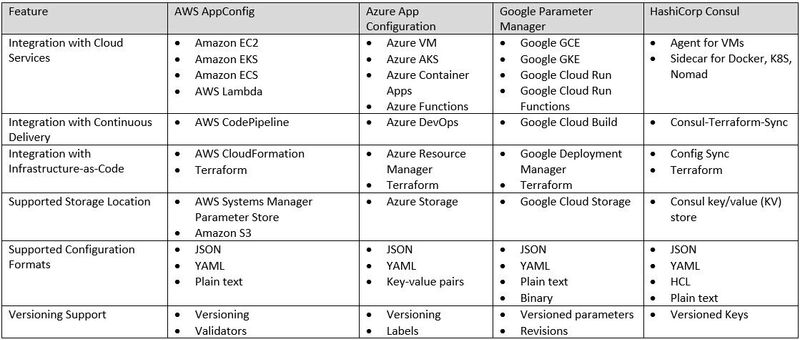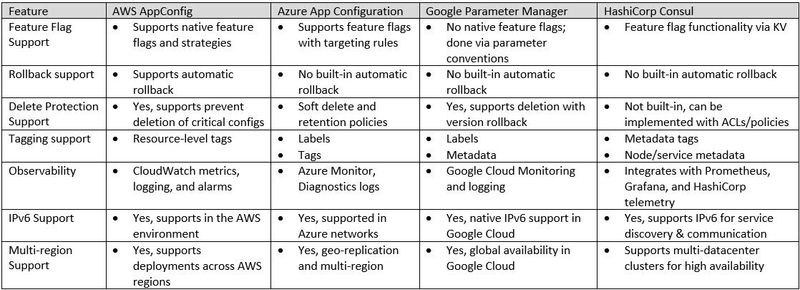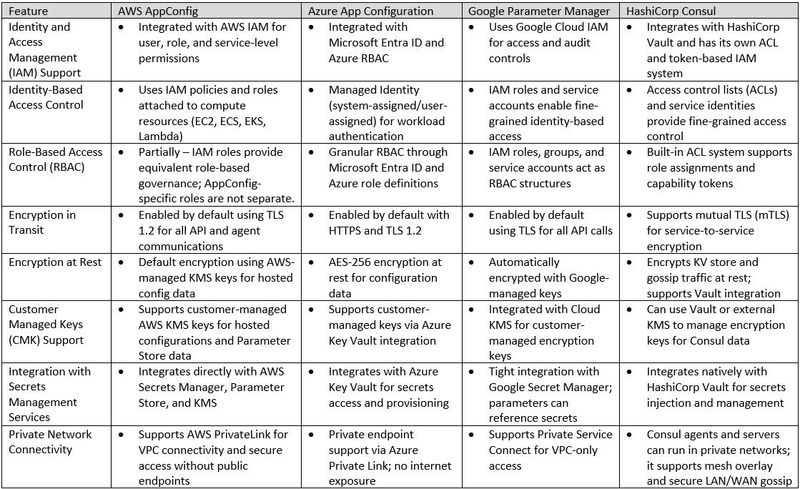When designing cloud-native applications and following the Twelve-Factor App methodology "Config" factor, we should separate config from code to ensure portability, scalability, and security.
Common configuration variables include:
- Database connection strings or URLs (DATABASE_URL)
- API keys and external service credentials (API_KEY)
- hostnames, ports, and environment labels (SERVICE_URL, PORT, ENVIRONMENT)
- Caching or message broker endpoints (CACHE_HOST, CACHE_PORT)
- Debugging or logging levels (LOG_LEVEL, DEBUG_MODE)
Application configuration services are especially useful when automating a CI/CD pipeline to build and deploy cloud-native applications, allowing us to retrieve configuration from a central repository for different environments as part of an SDLC process, and to revert configuration in case problems are identified.
In this blog post, I will compare some of the most common features of managed configuration services, offered by the hyper-scale cloud providers, and a cloud-agnostic solution.
Feature comparison
Security-related feature comparison
Summary
Application configuration services are essential for modern cloud-native applications because they centralize and separate configuration from code, supporting scalability, security, and portability. They enable automated, environment-specific configuration management that integrates seamlessly with cloud services, CI/CD pipelines, and infrastructure-as-code tools, ensuring safe deployments with features like versioning and rollback.
In this blog post, I have compared application configuration services (both vendor agnostic and non-vendor agnostic), in various aspects – from supported capabilities (such as versioning, service integration, feature flag support, to IAM, encryption, etc.)
I encourage the readers to select an application configuration service and integrate it as part of a CI/CD pipeline, and separate config from code.
Disclaimer: AI tools were used to research and edit this article. Graphics are created using AI.
References
- What is AWS AppConfig?
- What is Azure App Configuration?
- Google Parameter Manager overview
- HashiCorp Consul Documentation
About the author
Eyal Estrin is a seasoned cloud and information security architect, AWS Community Builder, and author of Cloud Security Handbook and Security for Cloud Native Applications. With over 25 years of experience in the IT industry, he brings deep expertise to his work.
Connect with Eyal on social media: https://linktr.ee/eyalestrin.
The opinions expressed here are his own and do not reflect those of his employer.






Top comments (3)
This post is both insightful and relatable. I appreciate how you shared not just your successes but also the process behind them. It’s posts like these that push the community forward. If you’re into exploring new ideas and digital innovations, Borneojitu also shares great resources worth checking out!
Great content! I run InstagramNamesStyles and I always love seeing creative ideas like this. Your breakdown of aesthetic vs unique vs trending styles is spot on.
That's great, I really appreciate this deep dive—best comparison between AWS App Coding and Azure App Configuration.